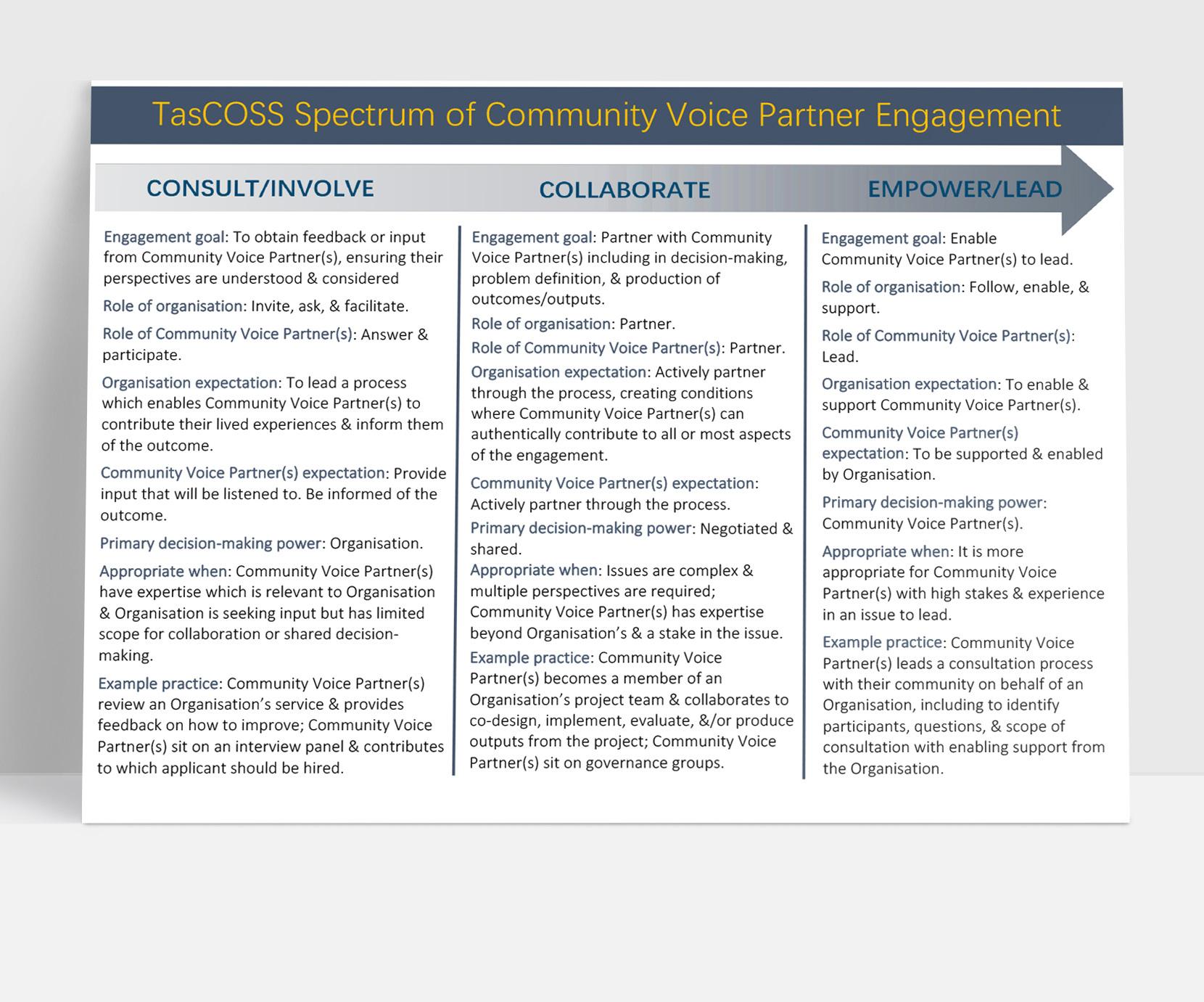
4 minute read
Engagement checklists
The below checklists walk you through some ways you can prepare to help make the engagement good for you and the people you engage with.
BEFORE ENGAGEMENT
Advertisement
Before the first meeting of an engagement—these are things you can do to prepare yourself and others prior to the first introductory meeting.
You have read this guide and any other resources given to you, including doing the reflective guide below. You have filled out and provided your ‘Engagement needs and expectations’ form to TasCOSS. You are clear on your role in the engagement according to the TasCOSS Community Voice Partner Engagement Spectrum above and understand the details as outlined in the Organisational request form given to you. You know who the primary and secondary contacts are within the organisation you will work with and how to contact them if you need to. You have read any preparation information for the engagement provided by the organisation or TasCOSS. You have confirmed your attendance at the first meeting. You have prepared any notes that you need, including any questions for the organisation, ready for the first meeting. You know when and where the first meeting is and have planned how to get there on time. You have asked TasCOSS for support on anything that is unclear.
FIRST INTRODUCTORY MEETING
The organisation will lead this meeting but here are some things you might expect to do or discuss in the meeting.
Introduce yourself (name, pronouns, something about yourself). Discuss the roles of each staff member and your role in the engagement. Activity details for each engagement event (if more than one) should be provided clearly and with appropriate information. If not, you can ask for more details. Privacy or confidentiality requirements of the engagement. Audience or additional people involved in engagement. Discussion of level of engagement and how you will influence outcomes and be kept up to date on those outcomes after the engagement. Recording (audio/visual) of any engagement activities. Feedback processes between the you and the organisation. Questions and suggestions you have for the organisation. Discuss what you wrote on your ‘Engagement needs and expectations’ form. Confirm if these have been met so far with feedback or suggestions for future engagements. Safety requirements are discussed in terms of any physical, emotional, and cultural safety supports you might want to have in place beyond those outlined in the ‘Engagement needs and expectations’ form. Privacy or confidentiality requirements. Boundaries are established regarding topics or activities you do not which to discuss or take part in.
PRIOR TO EACH ENGAGEMENT ACTIVITY
You have confirmed your attendance for each engagement (if more than one). You have read any preparation information for the engagement provided by the organisation or TasCOSS. You have prepared any notes that you need, including questions for the organisation. If you are making any kind of speech, you have prepared your notes and practiced what you are going to say, ensuring it is clear and to time. You know who the primary and secondary contacts are within the organisation and how to contact them if you need to. You know when and where the engagement is and have planned how to get there on time—usually it is good to arrive at least 10-15minutes before the engagement starts. Ask TasCOSS or the organisation for support on anything that is unclear. If the event is in person, check you know where the toilets are and ask for anything you need to feel welcome, safe, and comfortable (e.g., glass of water, comfortable chair etc.). Ask any questions you need to know of the organisation.
DURING ENGAGEMENT
Introduce yourself as agreed prior with the organisation. Ask questions when you don’t understand. Speak clearly and confidently—people will definitely want to hear what you say! Keep language simple. Decline to answer a question if you do not wish to by referring it to the primary or secondary contact. Be aware of how you are feeling. Ask for a break if you need one. Keep to time.
AFTER ENGAGEMENT
Invite feedback from the organisation if you want to. Could you have done anything differently or better? Offer feedback by sharing your reflections on how the engagement went if you want to. What did the organisation do well and how could they improve next time? Confirm next steps from the engagement. Make sure you understand what you need to do, including a timeline for actions and follow up for both you and the organisation. If there are any action items or follow up, make sure you do these in a timely manner as agreed with the organisation. If for some reason you cannot do these, communicate with the organisation to discuss alternative options or timelines. Debrief with TasCOSS as needed.
IN THE EVENT OF A MISHAP
Try addressing the issue directly with the organisation if you feel comfortable doing so. Contact the TasCOSS Community Voices Program Coordinator to discuss. If the mishap is in relation to the Program Coordinator, contact the secondary TasCOSS contact. Refer to the ‘Grievances (Complaints)’ section of your registration pack.
This resource was adapted from the open access Safe + Equal ‘Survivor Advocate Engagement Checklist.’



